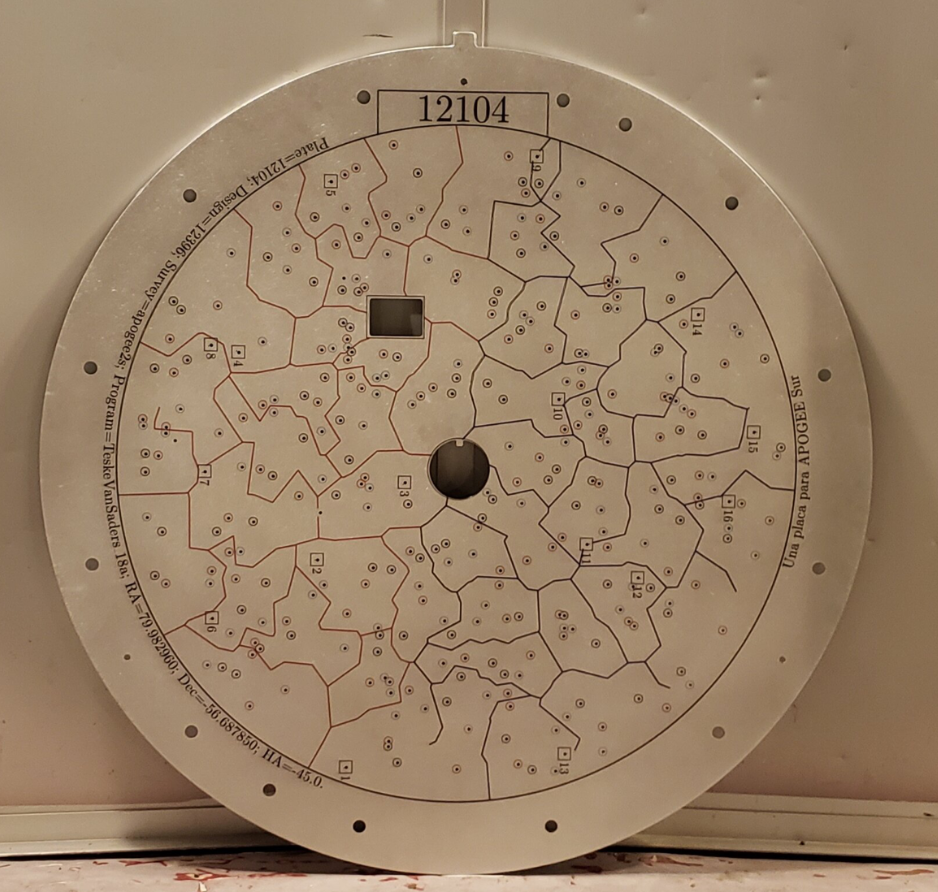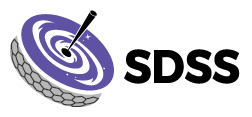Plates in the SDSS context are round pieces of aluminum with holes in it to plug the fibers that collect the light from each astrophysical object. For many years in SDSS we have used this plug plates to perform our observations. These plates need to be designed and drilled with a few months in advance so that they can arrive on time to the telescope for the observations.
For the limited SDSS-V plate program, we introduced a new hybrid BOSS+APOGEE observing mode – whereby each plug plate is simultaneously populated by a combination of 500 fibers leading to the BOSS spectrograph, and 300 fibers leading to the APOGEE spectrograph. This innovation was accompanied by a suite of procedural and software updates to manage the new plate design process.
In the SDSS-V plate era, each observing run consists of a list of plates planned for observation. Each plate is created to observe a set of targets from a given field (a region of the sky), and it is drilled to observe around a specific hour angle to account for atmospheric refraction effects. Then, the targets a plate were assigned using a specific combination of cartons (see MWM cartons and BHM cartons) which correspond to sets of targets with a specific science goal selected with a single selection algorithm. For each plate, we created a prioritized list of cartons to fill the fibers for each spectrograph. This means that to fill APOGEE and BOSS fibers we covered the corresponding list of cartons in priority order until all fibers for each instrument were filled. This fiber filling rule was shared by multiple plates in the same observing run or even across different runs, but one shift in priority of a carton with respect to another or an update on the version of the carton that was used implies a different fiber filling rule. Each combination of fiber filling rule and field of a plate (i.e. unique set of targets) was identified with a design id.

Example of an SDSS-IV APOGEE plate. Small holes spread through the entire plate correspond to the places were fibers are plugged, medium size holes at the edges of the plate are drilled to fix the plate to the focal plane while the larger 2 holes were drilled to place acquisition cameras in SDSS-IV but those are not used anymore. Photo by R. Beaton.
SDSS-V/eFEDS plates
The only new spectroscopic data being released in DR18 is associated with the ‘eROSITA Full Equatorial Depth Survey’ (eFEDS) field. Therefore we provide some more detail here about the SDSS-V plug plates that were produced for the SDSS-V/eFEDS project. Target cartons that were considered for the SDSS-V/eFEDS plates are described here.
SDSS-V/eFEDS plates were designed within two plate ‘runs’ (independent iterations of the tiling/plate design process). The first of these plate runs (‘2020.11.a.bhm-mwm’), consisted of a set of 31 plates spanning most of the c.140 deg2 eFEDS field, with an inner region (roughly corresponding to the GAMA09 field, Driver et al. 2009) being targeted with two plates per sky position. The large fractional overlap between the eFEDS plates required special attention to ensure proper control over which targets were prioritized in which plates (the standard platedesign software treats all plates independently). Our initial attempt to manage this complexity exploited the ‘ebosstile’ software, which had previously been utilized to manage overlapping plates within the SDSS-IV/eBOSS project. Unfortunately, due to an unrealistic model of fiber reach constraints being used in the tiling+plate design software, a number of the plates from the ‘2020.11.a.bhm-mwm’ plate run were later deemed to be ‘un-pluggable’, and were discarded. Consequently, only 20 of the ‘2020.11.a.bhm-mwm’ plates were put forwards for observation at the telescope.
A second eFEDS plate run (‘2021.01.a.bhm-mwm’), was designed to recover eFEDS targets from the rejected plate designs, and to take advantage of more optimistic projections of the available observing time and plugplate manufacturing resources. We rapidly devised a heuristic tiling algorithm which included a more conservative model of fiber reach, took account of plate overlap regions, and de-prioritized targets which had been assigned fibers in the 20 accepted plates of the 1st eFEDS plate run (‘2020.11.a.bhm-mwm’). The ‘2021.01.a.bhm-mwm’ plate run contains 17 plates, all of which were submitted for observation at the telescope.
For each of these 37 SDSS-V/eFEDS plates, we reserved at least 80 BOSS fibers per plate for skies, and 20 BOSS fibers for spectrophotometric standard stars, leaving up to 400 BOSS fibers for science targets. In order to mitigate the worst effects of on-chip crosstalk between neighbouring fiber traces, we applied a bright limit for science targets of gPSF,rPSF,iPSF > 16.5 AB, and avoided placing fibers anywhere near brighter stars. Each SDSS-V/eFEDS plate was drilled at an Hour Angle (HA) of either -15, 0, or +15 deg; this range of HAs allowed for greater observing flexibility.
The SDSS-V/eFEDS plates also included up to 300 APOGEE targets per plate; these will be presented in a future SDSS data release.
Bitmasks
Throughout the year SDSS has used bitmasks to identify properties of the targets. In DR18 we have defined 3 new set of bitmasks called SDSSV_BOSS_TARGET0, SDSSV_APOGEE_TARGET0, and GRI_GAIA_TRANSFORM. The first two were used to identify the carton(s) to which each target belongs, while the last one used to identify magnitude transformations applied to the targets, bright Gaia neighbours, and position offsets applied to observe stars brighter than our nominal bright limit. Magnitude transformations were used when the magnitude stored at the moment the target was ingested to our database was absent or unreliable. In some cases we used the Gaia to SDSS magnitude transformation from Evans et al. 2018 where Gaia G magnitudes and (bp-rp) colors are used to obtain SDSS gri magnitudes. Bits 0 to 14 in GRI_GAIA_TRANSFORM are used to indicate for each magnitude if this transformation was applied, if it can’t be applied because the (bp-rp) color is outside the range in which the transformation is defined, and if the transformation can’t be applied because (bp-rp) color is not available. Bits 16-19 in GRI_GAIA_TRANSFORM are used to identify griz magnitudes taken from the PanSTARRS1 catalogue. Finally bits 15 and 20, are used to identify targets with bright neighbours, and targets for which spatial offsets were applied respectively. Description of these and other bitmasks defined in DR18 are shown in bitmasks.
Calibration targets
To calibrate APOGEE and BOSS data each exposure must include observations of two types of calibration targets: telluric standards and “empty” skies.
Telluric Standards
Telluric standards are hot bright stars that are used as an approximation of a featureless blackbody emission to measure in them absorption bands and emission lines produced by the Earth’s atmosphere. Our data reduction pipeline uses these observations to remove the telluric features from our science observations. Multiple cartons are defined to select telluric standards for APOGEE and BOSS, but the main idea is to divide the sky in small regions, then apply color, magnitude and photometric quality cuts on the stars in that region, and finally select the bluest stars available. If the stars from a carton are not enough to select the necessary amount of standards for an instrument, then a lower priority carton is used to select the remaining stars. Ideally, the final sample of standards is spread more or less homogeneously over the field of view to map spatial variations of the telluric features. Cartons created to select APOGEE standards have been flagged with bits 1 and 3 in SDSSV_APOGEE_TARGET0, while BOSS standard cartons have flags 1,2,3, and 4 in SDSSV_BOSS_TARGET0.
Cartons ops_std_eboss, ops_boss_stds, and ops_std_boss_red cartons were the original cartons used for boss standards in the plate-era, and selected in that order of priority. Later, ops_std_boss_tic cartons was introduced at the same priority as ops_std_boss. For the case of apogee standards, first plateruns from plate-era used the same selection method as the one used in SDSS-IV/APOGEE (Zasowski, et al. 2017), which are flagged as coming from the “hacked” carton ops_std_2mass, which have SDSSV_APOGEE_TARGET0=3 bit flag, but are not included in the targeting database as an actual carton. Then, for the later stages of plate-era and the FPS-era we started using carton ops_std_apogee. Details about all these cartons can be seen in Standards Calibration
Skies
Sky observations are meant to monitor “empty” sky airglow. To select suitable empty-sky positions, we check a group of external catalogues (for example GAIA, 2MASS, Tycho2) and select the positions that don’t have a close detection in any of the catalogues analyzed. We also split the sky into small regions and select good sky candidates from all of them to ensure that the sources are well distributed across the fields of view of our observations. Cartons created to select APOGEE skies have been flagged with bits 0 and 2 in SDSSV_APOGEE_TARGET0, while BOSS skies cartons have flags 0, 5, and 6 in SDSSV_BOSS_TARGET0.
First plateruns from plate-era used ops_sky_2mass to select apogee skies, for which we used the same selection method as in SDSS-IV/APOGEE (Zasowski, et al. 2017), which are flagged as coming from the “hacked” carton ops_sky_2mass, which have SDSSV_APOGEE_TARGET0=2 bit flag, but are not included in the targeting database as an actual carton. Then we replaced this carton with ops_sky_apogee to select apogee skies, whereas for BOSS the original carton used was ops_sky_boss. Details about all these cartons can be seen in Sky Calibration.
